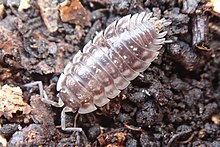Oniscus asellus
| Oniscus asellus | |
|---|---|

| |
| Scientific classification | |
| Domain: | Eukaryota |
| Kingdom: | Animalia |
| Phylum: | Arthropoda |
| Class: | Malacostraca |
| Order: | Isopoda |
| Suborder: | Oniscidea |
| Family: | Oniscidae |
| Genus: | Oniscus |
| Species: | O. asellus
|
| Binomial name | |
| Oniscus asellus | |
| Synonyms [1] | |
| |
Oniscus asellus, the common woodlouse, or common shiny woodlouse[2] is one of the largest and most common species of woodlouse native to the British Isles and Western and Northern Europe, growing to lengths of 16 mm and widths of 6 mm.
Distribution
[edit]The common woodlouse is the most widespread species of woodlouse in the British Isles, both geographically and ecologically.[3] It is rare in the Mediterranean Basin, but is widespread in Northern and Western Europe, as far east as Ukraine, as well as in the Azores and Madeira; it has also been widely introduced in the Americas,[1] predominantly in Mexico and in the United States, east of the Mississippi River and west of the Rocky Mountains.[2]

Ecology
[edit]The common woodlouse occurs in a wide range of habitats, including some with little available calcium. It is chiefly found under stones, and on rotting wood.[3] It is the only woodlouse regularly found on heather moors and blanket bogs, where it lives around items such as rotting fenceposts.[3]
Description
[edit]The common woodlouse is one of the largest native woodlice in Britain, at up to 16 mm (0.63 in) long.[4] It is relatively flat, and is a shiny brown/grey in colour,[3] although juveniles are rougher.[4]

Pale patches are often visible on the back of Oniscus asellus; these are areas that store calcium, which is then used to reinforce the exoskeleton after a moult.[4] Moulting occurs in two halves, with the rear half moulting before the front half. The exuvia (the thing that is being moulted) is often consumed by the animal after moulting.[4]
See also
[edit]References
[edit]- ^ a b Helmut Schmalfuss (2003). "World catalog of terrestrial isopods (Isopoda: Oniscidea) – revised and updated version" (PDF). Stuttgarter Beiträge zur Naturkunde, Serie A. 654: 341 pp.
- ^ a b "Common Shiny Woodlouse". inaturalist.org. Retrieved 2024-06-15.
- ^ a b c d Paul T. Harding & Stephen L. Sutton (1985). Woodlice in Britain and Ireland: distribution and habitat (PDF). Abbots Ripton, Huntingdon, Institute of Terrestrial Ecology. p. 151. ISBN 0-904282-85-6. accessed through the NERC Open Access Research Archive (NORA)
- ^ a b c d "Common woodlouse (Oniscus asellus)". ARKive.org. Archived from the original on 2010-04-29. Retrieved February 22, 2009.
External links
[edit] Media related to Oniscus asellus at Wikimedia Commons
Media related to Oniscus asellus at Wikimedia Commons
